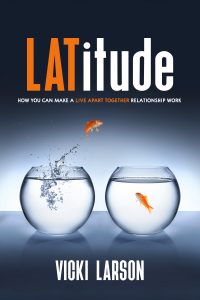Vicki Larson specializes in writing about living and loving outside conventional models of coupling and the nuclear family as well as busting ageist and sexist narratives about aging as a woman and women’s sexuality and desire. The former longtime lifestyles editor, writer and columnist for the Marin Independent Journal, her writing can also be found in The New York Times, The Washington Post, The Guardian, Newsweek, AARP’s The Ethel, The Huffington Post, Medium and elsewhere. Here, I ask her about her new book, LATitude: How You Can Make a Live Apart Together Relationship Work. You may find more about her on her website https://www.vicki-larson.com, and follow her on Twitter/X at https://twitter.com/OMGchronicles, Threads: https://www.threads.net/@omgchronicles?hl=en and Instagram, https://www.instagram.com/omgchronicles.
AMW: Why is the secret to stronger long-term relationships spending a healthy amount of time together and apart?
VL: I think famed Belgian psychotherapist and author Esther Perel said it best in her 2006 book, Mating in Captivity: Unlocking Erotic Intelligence—“separateness is a precondition for connection: this is the essential paradox of intimacy and sex.”
According to many who study romantic relationships, we have come to rely on our romantic partners to be our everything—best friend; soulmate; lover; co-parent; great communicator; romantic, intellectual, and professional equal; companion, and financial partner, and also provide us with happiness, fulfillment, financial stability, intimacy, social status and fidelity. More and more, however, we are seeing how unstainable that is in the long term. Many people are seeking out what’s been called OSO, other significant others—whether family members, friends or other types of platonic relationships to fulfill some of those needs.
Research by David M. Frost, a psychologist and professor of population and family health at the Mailman School at Columbia University, indicates that it really doesn’t matter how physically close you are to your partner as long as each of you feels as close as you want to be, even if it isn’t close by other people’s desires.
As much as we may want to be close to our romantic partner, we also have agentic needs, meaning our sense of freedom, independence, and self-mastery. If closeness interferes too much with our agentic needs, it’s troubling for the relationship.
How much time together and apart is up to a couple to decide, hopefully a healthy balance that honors the desires of each person as well as the couplehood.
AMW: Why do you think that live apart together relationships have been making headlines and sparking online conversations in recent years? Why the sudden interest?
VL: LAT relationships have long existed and been studied in England and Europe, where they are more common, but they’ve garnered more attention recently in the States because of two things—the rise of so-called gray divorce and the pandemic lockdowns.
Divorced and widowed women in their 60s and older are overwhelmingly driving the live apart together lifestyle in part because they feel like they’ve “been there, done that” in previous heterosexual relationships and see LAT as a way to “undo gender.” They can enjoy the best of a committed, loving romantic relationship without having to give up their freedom. In fact, LAT relationships have been called the “gender revolution continuing into old age,” according to two Swedish researchers —a nod to the fact that baby boomer women have been on the forefront of restructuring family life in the past few decades, especially after no-fault divorce was written into law across the United States.
Also, the pandemic revealed the difficulties of living 24-7 with a romantic partner. Unable to go to work, school or other activities that got people out of the house for a few hours, it was the first time many couples experienced so much togetherness, and it felt suffocating for some. Too much closeness can negatively impact a relationship as well as each person’s well-being, research has shown. Then, some people had to sleep and live apart temporarily, such as health care workers who were caring for COVID patients or a family member who came down with COVID and had to isolate themselves to protect their loved ones, and some came to realize that they actually liked some time and space to themselves. So, an unplanned global event gave some couples a chance to experience a different way of being together.
AMW: What are the myths about live apart together couples?
VL: There are several, but one of the biggest is that LAT relationships are only for the wealthy. Except all romantic couples start off living in separate households, whether solo or with parents, friends, roommates, or some other configuration. Nothing about their living situation has to change just because they found someone they’re in love with. Yes, it’s cheaper to live together, but that’s turning a romantic decision into a financial decision.
Another myth is that LATs are more likely to cheat. It’s true—sometimes LATs cheat on their partner. But so do people who live together. It’s hard to know how many people fool around on their romantic partner—people aren’t always honest about such things— but since many more couples live together than live apart, it’s obvious that living together doesn’t prevent anyone from cheating.
Others look at all LAT couples as just dating, not as committed loving unions whether they’re married or not. Some people who live apart are indeed dating, but many are what have been called “partner LATs,” who are deeply enmeshed in each other’s lives, are executors of each other’s estates, have each other’s powers of attorney, etc.
Some see the lifestyle as being bad for the environment. It’s true that many housing units, whether a 250-square-foot studio or a 2,500-square-foot single-family house, have their own appliances, and heating and cooling systems, etc. All that has impacts on the environment.
More important, however, is how the people in those units actually live. If you’re a family of three or four in one household, yes, you are sharing resources and that can be better for the environment. But if that family often flies for work or vacations, drives gas-guzzling luxury cars, trucks or SUVs, dines on beef a few times a week and has remodeled their perfectly fine kitchen or bathroom to keep up with new decor trends, their carbon footprint will likely be much higher than that of a solo LAT dweller who lives minimally, perhaps walks, bikes, uses mass transit, or has an electric vehicle; shops at consignment and resale stores; and is vegetarian or vegan. Lifestyle matters.
Finally, many don’t believe that you can live apart and raise children together. But there are many children being raised with one parent at home and one who commutes for work and only comes back to the family home for short visits, or who is deployed overseas, or is incarcerated, or any configuration that keeps them apart for lengths of time. Plus, many people in platonic relationships co-parent in separate places as do divorced parents. All that matters is that the parents put their children’s needs—to feel safe, secure and loved—first. According to the research-based center Zero to Three, children need “parents who, whether living together or not, demonstrate respect for each other, communicate calmly and without anger, and who make their child’s needs the central focus of their decision-making.”
Vicki Larson is a longtime award-winning journalist, author of Not Too Old for That: How Women Are Changing the Story of Aging, coauthor of The New I Do: Reshaping Marriage for Skeptics, Realists, and Rebels, and author of the upcoming book, LATitude: How You Can Make a Live Apart Together Relationship Work. You may find more about her on her website https://www.vicki-larson.com, and follow her on Twitter/X at https://twitter.com/OMGchronicles, Threads: https://www.threads.net/@omgchronicles?hl=en and Instagram, https://www.instagram.com/omgchronicles.
Alicia M. Walker is Associate Professor of Sociology at Missouri State University. She is the current editor of the Council of Contemporary Families blog. Follow her on Twitter at @AliciaMWalker1.



Comments